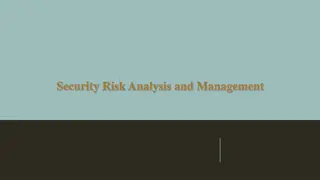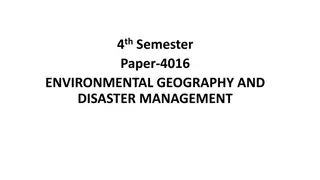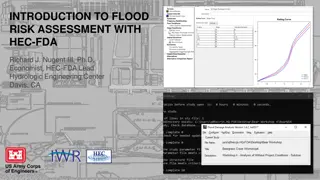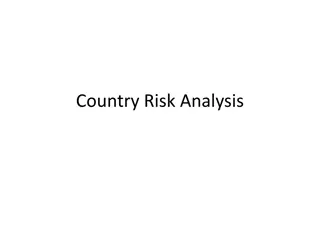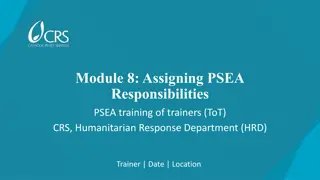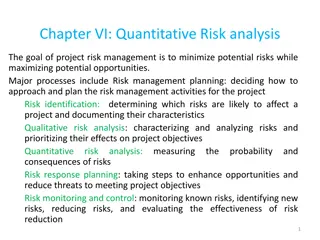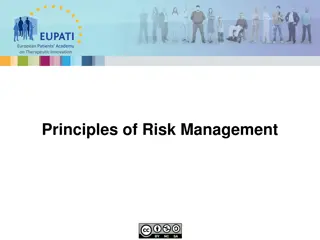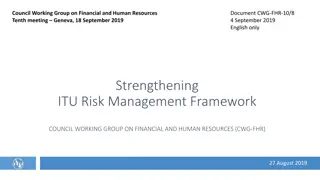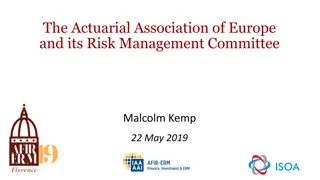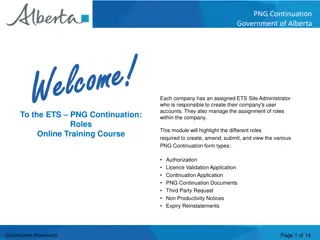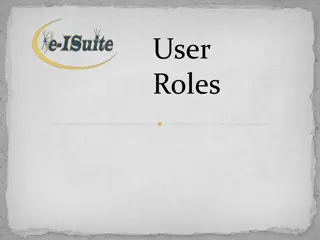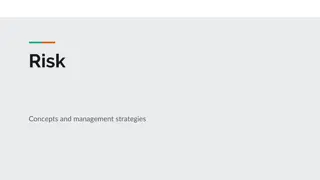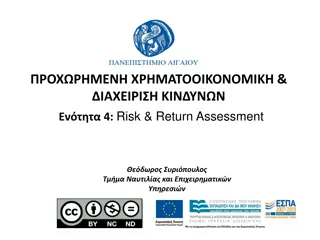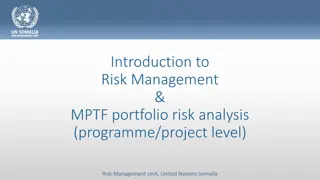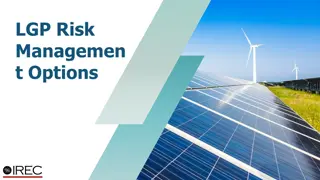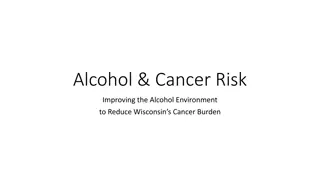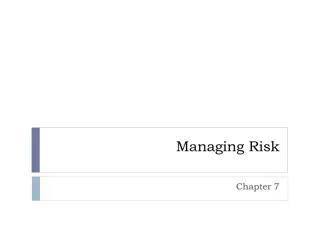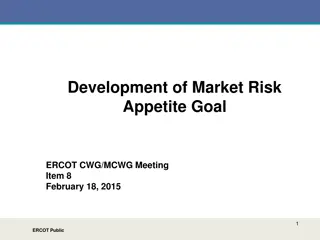
Risk Management Roles and Responsibilities in Organizations
Discover the crucial roles and responsibilities of internal stakeholders in the process of risk management within organizations. Learn how everyone, from management to employees, plays a vital part in effectively identifying and managing potential risks to achieve organizational objectives.
Uploaded on | 0 Views
Download Presentation

Please find below an Image/Link to download the presentation.
The content on the website is provided AS IS for your information and personal use only. It may not be sold, licensed, or shared on other websites without obtaining consent from the author. If you encounter any issues during the download, it is possible that the publisher has removed the file from their server.
You are allowed to download the files provided on this website for personal or commercial use, subject to the condition that they are used lawfully. All files are the property of their respective owners.
The content on the website is provided AS IS for your information and personal use only. It may not be sold, licensed, or shared on other websites without obtaining consent from the author.
E N D
Presentation Transcript
RISK MANAGEMENT ROLES AND RESPONSIBILITIES 4/13/2025 1
OUTLINE INTRODUCTION ROLE OF INTERNAL STAKEHOLDERS ROLE OF EXTERNAL STAKEHOLDERS RISK MANAGEEMNT AND COMPLIANCE COMPLIANCE RISK MANAGEMENT ROLE OF INTERNAL AFFAIRS ROLE OF BOARD OF DIRECTORS ROLE OF INTERNAL AUDIT CONCLUSION CASE STUDY 4/13/2025 2
INTRODUCTION Think of an activity in your organization for which there is no clearly defined responsible party a person or group. Now think of how well that activity is being performed its efficiency and effectiveness. We all realize that if such activity exist, we will actually have a disaster. This is true of any activity addressing taxpayers enquiries, following up with late filers, enforcing management directives, analyzing tax returns, reconciling bank accounts, etc. 4/13/2025 3
INTRODUCTION Risk management is a process, affected by an entity s board of directors, management and every personnel, applied in strategy setting and across the enterprise, designed to identify potential events that may affect the entity, manage risk to be within its risk appetite and to provide reasonable assurance regarding the achievement of entity s objectives. Everyone in the organization, from the board to floor employee has varied roles and responsibilities in the risk management process. 4/13/2025 4
INTRODUCTION There should be appropriate, full and timely involvement of all stakeholders and in particular, decision makers at all levels within and outside of the organization to ensure that risk management remains effective, relevant and up-to-date. The involvement of everyone in the organization allows stakeholders to be properly represented, informed and to have their views taken into account in determining risk criteria and implementing risk treatment strategies. 4/13/2025 5
ROLE OF INTERNAL STAKEHOLDERS Management and employees at various levels of the organization have duty of care to the organization. For example, a receptionist at the front desk needs to be courteous and professional in interacting with outsiders (including taxpayers), in addition to providing accurate and complete information. 4/13/2025 6
ROLE OF INTERNAL STAKEHOLDERS Internal stakeholders can be divided into the following groups: Executive management; Senior management; Middle management; Line management; and Floor employees. Each group of stakeholders has varying roles and responsibilities in the risk management process. 4/13/2025 7
ROLE OF INTERNAL STAKEHOLDERS Line management and their floor employees are the first line defense in the risk management process as their actions or inactions directly affect the organization. In revenue authorities, line management and floor employees are those that directly interact with taxpayers. They become either an asset or a liability depending on their interactions with taxpayers. The role of executive management is to set risk management policy with the approval of the board of directors. 4/13/2025 8
ROLE OF INTERNAL STAKEHOLDERS Executive management provides strategic oversight and direction in the risk management process, including approving and directing resources. Senior and middle management provide direct supervision and oversight on the activities of line management and their floor employees. 4/13/2025 9
ROLE OF INTERNAL STAKEHOLDERS Enterprise risk management and compliance and internal audit also play crucial role in the organization s risk management. The inclusion of all internal stakeholders in the formulation of risk management framework, policies and procedures will ensure ownership and participation of everyone. 4/13/2025 10
ROLE OF EXTERNAL STAKEHOLDERS External stakeholders are those outside the direct control and supervision of the organization but play key role and exert significant influence on the entity. The involvement of external stakeholders in the risk management strengthens the scope of the process. 4/13/2025 11
ROLE OF EXTERNAL STAKEHOLDERS Impotent external stakeholders to a revenue authority may include: Financial institutions; Other government ministries and agencies; Law enforcement agencies; Business and property registries; Other revenue authorities; 4/13/2025 12
ROLE OF EXTERNAL STAKEHOLDERS Utility and power companies; Parliament; Judiciary; Public record companies; Law firms; Accounting firms; Trade associations; Labor unions; Foreign governments; Non-governmental organizations; etc. 4/13/2025 13
RISK MANAGEMENT AND COMPLIANCE The enterprise risk management and compliance function daily responsibility is to monitor, review and ensure compliance within the organization. It serves as the second line defense in ensuring that the overall risk management process is adequate, proactive and effective. In most organizations, the compliance risk management function is a component of enterprise risk management but may have reporting responsibility to the head of relevant core function. 4/13/2025 14
RISK MANAGEMENT AND COMPLIANCE In some tax administrations, enterprise risk management and compliance reviews tax bills before they are issued to taxpayers. It may also review the audit case selection process and cases selected for audit to ascertain whether selection process is in line with the compliance risk management policies and cases selected meet the criteria for audit. 4/13/2025 15
COMPLIANCE RISK MANAGEMENT Compliance risk management identifies, analyzes and evaluates taxpayers compliance profile for instituting strategies to ensure compliance with the tax legislations. It focuses on risks related to taxpayers compliance obligations: Registration risks; Filing risks; Reporting risks; and Payment risks. 4/13/2025 16
COMPLIANCE RISK MANAGEMENT Risks related to weaknesses in the tax administration, for example, capacity gaps, are dealt with by enterprise risk management. Compliance risk management induces voluntary compliance and increase tax collection. It helps revenue authorities understand what, how and why questions influencing taxpayers behavior. 4/13/2025 17
ROLE OF INTERNAL AFFAIRS Internal affairs function is usually but not always composed of the professional ethics and tax investigation functions. The role of professional ethics is to investigate and deal with employees ethics and integrity issues. Because ethics and integrity are very important in risk management, professional ethics plays crucial role in ensuring that tax officers comply with tax laws and rules of conduct. 4/13/2025 18
ROLE OF INTERNAL AFFAIRS Tax investigators conduct forensic audits and investigations of taxpayers perceived of engaging in deliberate tax evasion. It is critical to enforce compliance with tax law as there will always be taxpayers who will deliberately evade taxes. An effective tax investigation serves as deterrent to would be future tax evaders if tax authorities can detect and penalize fraudulent behavior. 4/13/2025 19
ROLE OF BOARD OF DIRECTORS The board provides strategic oversight and supervision of executive management. It sets the strategic directions of the entity including approving risk management policies. The board risk management committee reviews and approves risk management policies and strategies. It also reviews risk management reports and provides independent oversight of organization s risk management. 4/13/2025 20
ROLE OF BOARD OF DIRECTORS Key roles of board risk management committee are: Reviewing and approving risk management policies; Reviewing and approving risk management strategies; Setting maximum risk appetite; Reviewing and taking actions on risk management reports; and Serves as critical voice and advice to executive management on risk management issues. 4/13/2025 21
ROLE OF INTERNAL AUDIT Internal audit is an independent, objective assurance and consulting services aimed at assisting the organization achieve its objectives. It brings a systematic and disciplined approach to evaluate and improve the effectiveness of governance, risk management and control processes. The role of internal audit is to independently and objectively evaluate the risk management process for purposes of providing reasonable assurance and recommendations for improvement. 4/13/2025 22
ROLE OF INTERNAL AUDIT Internal audit provides assurance, insight and objectivity in risk management that assist management and the board make informed risk management decisions. Internal audit also monitors the disposition of results of its evaluation of risk management system to provide evidence that management have implemented agreed actions or that management have accepted the risk of taking no action. 4/13/2025 23
CONCLUSION There There must must be the the risk risk management management process Risk Risk management management should participation participation of of everyone Risk Risk management management should improvement improvement. . The The board board and and internal management management advice be clear clear description description of of roles process. . should be everyone in in the should foster foster accountability roles and and responsibilities responsibilities in in be inclusive inclusive and the organization organization. . accountability and and involve involve the the and continuous continuous internal audit advice. . audit are are independent independent sources sources of of risk risk 4/13/2025 24
CASE STUDY A A revenue revenue administration administration has management management initiatives initiatives have undertaken undertaken to to review review and Develop Develop and and approve Develop Develop and and approve Performance Performance review Prepare Prepare monthly monthly risk Conduct Conduct risk risk assessment Review Review and and direct direct actions In In a a group group of of five five persons, party party for for each each initiative initiative. . has discovered discovered that have been been poorly and clarify clarify these these roles approve strategic strategic risk approve operational operational policies review and and appraisal appraisal of of revenue risk management management and assessment of of the the organization actions on on risk persons, determine determine the that several several of of its poorly assigned assigned and roles and and responsibilities responsibilities: : risk management management policy policies and and procedures procedures. . revenue auditors auditors. . and compliance compliance report organization. . risk management management reports the functional functional responsible its risk risk and has has policy. . report. . reports. . responsible 4/13/2025 25
4/13/2025 26

